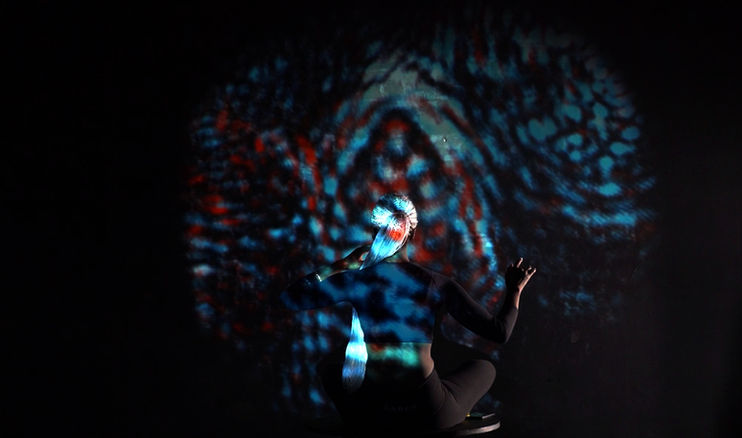Biography
Biography
Biography
A Drop of Light
An experimental Interactive installation + performance.
18-19 May 2023
-
Interactions zone: Nunnery theater, Wits east campus
-
Setup place: Structured Light Laboratory, School of Physics.
-
Software: TouchDesigner, MS team, Point Gray CCD camera controller.
-
Programming languages: MATLAB, Python.
-
Hardware: He-Ne Laser, Optical components for digital holographic setup, Smartphone, Microphone.
-
Keyword: human techno-attitude, technologically-mediated perception, technophilia, technophobia
Documentation:
>> Nature > Humanities & Social Sciences Communications.
>> Creative Applications
Supported sustainable development goals:

© Diaa Ahmedien. Videographer: Willem Burger.
A Drop of Light’ is a one-year interactive new-media art research project. It culminated in the creation of an experimental interactive installation performance. The project aimed at developing a computer-generated holographic spot as a responsive techno-hypermedium with which humans interact and their techno-perceptions are embodied, expressed, and analyzed.
TIMELINE

The project's last two-day experimental-interactive installation performance questioned the concept of degitized nature and the subsequent human relationship with light and sound, as two essential elements of nature, under the influence of today's dominant digitization wave.
In the Structured Light Lab (SLL), a digital holographic light spot was generated in an infinite responsive loop so that its patterns could produce a mutual response to the surrounding noises. On one hand, the generated holographic spot splits into two copies: the gray spot, which is the original nonresponsive one, and the colored spot, whose patterns and position are affected by the frequency of the surrounding voices. On the other hand, interactions between the two versions of the holographic spot synthesize a machinery melody in non-linear rhythms.
The real-time interactive installation was built to remotely communicate between the installation's optical setup in the SLL and the exhibition place. Thus, the holographic spot was generated, sustainably developed, and presented itself through real-time interactions with the exhibition room, creating a responsive environment.
The interactors were integrated into the holographic spot's visual, sound, and rendering processes. By establishing a remote connection between the performance zone and the holographic optical setup in the optics lab, the main performer and other interactors were enabled to acoustically communicate with the holographic setup.
As a result of the interactions between the holographic setup and the performer's voice frequencies, a dynamic holographic spot was produced. The performer performed a set of hymns in both English and South Africa's native languages, acoustically mimicking the holographic spots' synthesized non-linear melody. In response, the holographic pattern recognizes some hymns as texts and sends them back as echoes.
RESOURCES
ANALYSIS










The project hypothesizes that human hesitation between technophilia and technophobia should be defined and reinforced as a source of natural human self-guidance mechanisms, where pure technological determinism and avoidance are excluded. This hesitation establishes a perpetual cycle of conditional oscillation in which individuals weigh the advantages and disadvantages of both sides based on specific circumstances.
Each identified advantage encourages users to continue inspecting the same side until they find a disadvantage, which stimulates them to move towards the other to reveal its advantages. This process continues, with individuals moving back and forth between the two sides.
INTERACTIONS PHASES

The red tones group designates the three behavioral actions observed in the exploration phase, the blue tones group designates the three behavioral actions observed in the adaptation phase, and the green tones group designates the three behavioral actions observed in the symbiosis phase.
The two-day performance was recorded, one hour per day. Every one-hour recorded video was divided into 60 frames, one minute each, in order to analyze and summarize the performer's progressive interactive performance with the interactive hologram. The red rows are to place the recorded frames that refer to the exploration phase, while the blue and green rows are to place the recorded frames that refer to the adaptation and symbiosis phases, respectively.
The frames in three red tones inspect the exploration phase, during which the dialogues between the performer and the hypermedium were destructive, as the holographic medium operated in a nonresponsive gray mode and the performer assumed a fetal position. After a while, the performer recognized some of the hypermedium's parameters and worked on them to adapt her performance and get responses from the holographic spot, as the three blue rows' frames show.
After several adaptation attempts with the holographic spot, the performer developed a symbiotic conversation through which she and the holographic spot co-worked in constructive procedures with active results after several adaptation attempts, as the green rows' frames illustrate.
Click on any frame to see more details.
DOCUMENTARIES



![A Drop of Light: [video abstract]](https://i.ytimg.com/vi/u7Z4utAcmU0/mqdefault.jpg 1x, https://i.ytimg.com/vi/u7Z4utAcmU0/maxresdefault.jpg 3x)






© 2023 | Diaa Ahmed Mohamed Ahmedien | All rights reserved
Unless otherwise indicated, all materials on this website are copyrighted. No part of these pages, either text, audio, video, or images, may be used for any purpose unless explicit authorization is given. Therefore, reproduction, modification, storage in a retrieval system, or re-transmission in any form or by any means, electronic, mechanical, or otherwise, is strictly prohibited without prior written permission.

















































.webp)